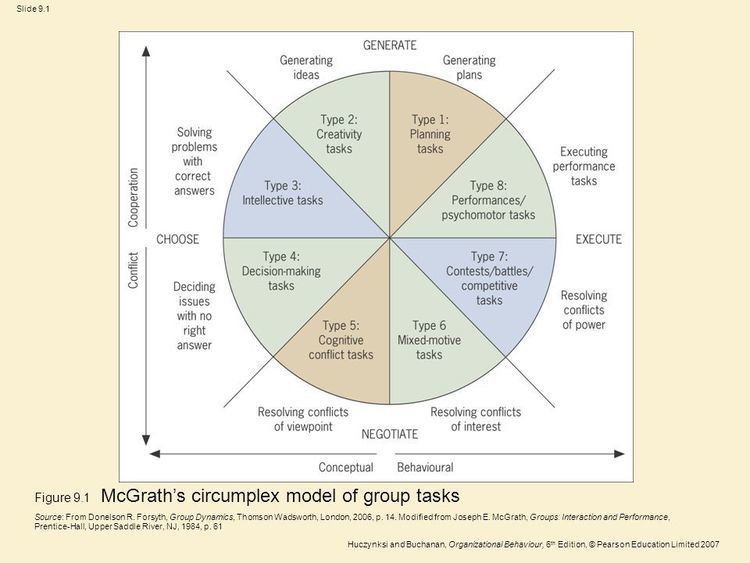Representation Goal-related activities Similar Robert F Bales, Hypostatic model of personality, Human action cycle | ||

Group dynamics
Group dynamics involve the influential actions, processes and changes that exist both within and between groups. Group dynamics also involve the scientific study of group processes. Through extensive research in the field of group dynamics, it is now well known that all groups, despite their innumerable differences, possess common properties and dynamics. Social psychological researchers have attempted to organize these commonalities, in order to further understand the genuine nature of group processes.
Contents
For instance, social psychological research indicates that there are numerous goal-related interactions and activities that groups of all sizes undertake . These interactions have been categorized by Robert F. Bales, who spent his entire life attempting to find an answer to the question, "What do people do when they are in groups?". To simplify the understanding of group interactions, Bales concluded that all interactions within groups could be categorized as either a relationship interaction (or socioemotional interaction) or a task interaction.
Development
Just as Bales was determined to identify the basic types of interactions involved in groups, Joseph E. McGrath was determined to identify the various goal-related activities that are regularly displayed by groups. McGrath contributed greatly to the understanding of group dynamics through the development of his circumplex model of group tasks. As intended, McGrath's model effectively organizes all group-related activities by distinguishing between four basic group goals. These goals are referred to as the circumplex model of group task's four quadrants, which are categorized based on the dominant performance process involved in a group's task of interest.
Breakdown
The four quadrants are as follows:
- Generating ideas or plans
- Choosing a solution
- Negotiating a solution to a conflict
- Executing a task
To further differentiate the various goal-related group activities, McGrath further sub-divides these four categories, resulting in eight categories in total. The breakdown of these categories is as follows:
1. Generating ideas or plans
2. Choosing a solution
3. Negotiating a solution to a conflict
4. Executing a task
Details
According to McGrath and Kravitz (1982), the four most commonly represented tasks in the group dynamics literature are intellective tasks, decision-making tasks, cognitive conflict tasks and mixed-motive tasks.
The circumplex model of group tasks takes the organization of goal-related activities a step further by distinguishing between tasks that involve cooperation between group members, cooperation tasks (Types 1, 2, 3 and 8) and tasks that often lead to conflict between group members, conflict tasks (Types 4, 5, 6 and 7). Additionally, McGrath's circumplex model of group tasks also distinguishes between tasks that require action (behavioural tasks) and tasks that require conceptual review (conceptual tasks). 'Behavioural tasks' include Types 1, 6, 7 and 8, while 'conceptual tasks' include Types 2, 3, 4 and 5.
Visual representation
The circumplex model of group tasks is recognized for its intricate and detailed structure. To facilitate a deeper comprehension of its characteristics, a visual representation of the model has been created. (Need a diagram of the model)
Further explanation
Since the circumplex model of group tasks is quite detailed and complex, numerous social psychological researchers have attempted to describe the model in various ways to ensure readers obtain an optimal understanding of the model. For instance, according to Stratus and McGrath (1994), the four quadrants and the various task types with which they contain all relate to one another within a two-dimensional space. More specifically, Stratus and McGrath (1994) states that the horizontal dimension of the circumplex model of group tasks visual representation reflect the extent to which a task entails cognitive versus behavioural performance requirements. Likewise, the vertical dimension of the circumplex model of group tasks visual representation reflects the extent and form of interdependence among members.
